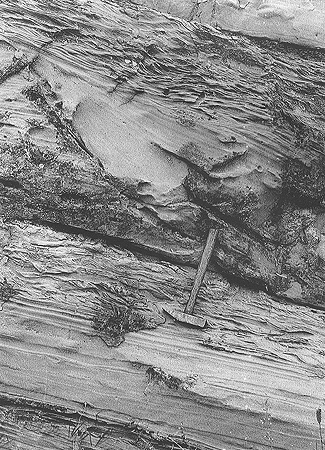
Scour-and-fill in amalgamated turbidite beds
Plate 77

Scour-and-fill in amalgamated turbidite beds
Plate 77
Going down in scale, erosional surfaces look like accessory features or decorations of beds, i.e., as sedimentary structures in the more traditional sense. For convenience, the scale will be qualified as medium (meso) when the objects are of the same order as dune bed forms and related cross-bedding, small in the range of ripples and related cross-lamination.
This photo was taken in the same outcrop of plates 8, 54, and 86, i.e., in sandy turbidite facies of the upper Marnoso-arenacea Formation in northern Apennines.
The cut is almost parallel to the paleocurrent direction, as indicated by the foreset laminae in the cross-laminated portion of the lower bed. The upper "bed" is actually composed of two beds, amalgamated along a diagonal curved surface that represents the longitudinal section of a scour. This erosional surface is locally marked by mudstone clasts. The scour fill consists of crude laminae dipping down current, a sort of small-scale prograding delta; it is covered by cross-laminae produced by climbing ripple drift, identical to those of the underlying bed. This interval extends to the left above the amalgamation surface, which becomes bed-parallel. Small pebbles are scattered in the sandstone of the fill, which basically shows the same vertical sequence as adjacent tabular beds with a flat base. In practice, the scour only locally modified the geometry of a regular turbidite layer.